The Family Race Car, part 3
Joel Wykeham
Joel.Wykeham@BBC.co.uk
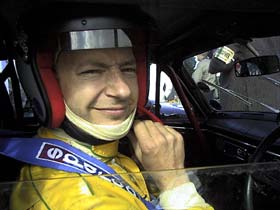 The final part in our plan to run the first-ever Volvo to be invited to the Goodwood Historic Revival Meeting, the world's premier Historic race weekend, in which both the circuit, and the spectators and participants, are dressed as if it were still the 1950s. Our Amazon was in the process of slowly being developed from its previous life as a rally car, with the intention that it would be a racer that was good for both family picnics as well as classic endurance competition on the same weekend. The final part in our plan to run the first-ever Volvo to be invited to the Goodwood Historic Revival Meeting, the world's premier Historic race weekend, in which both the circuit, and the spectators and participants, are dressed as if it were still the 1950s. Our Amazon was in the process of slowly being developed from its previous life as a rally car, with the intention that it would be a racer that was good for both family picnics as well as classic endurance competition on the same weekend.
Spa-Francochamps is an awesome road circuit set in the Ardennes region of Belgium. With the Amazon on a trailer this time, we arrived just two weeks after the Formula 1 Grand Prix for what was to be a festival weekend of Historic racing. We even managed a couple of learning laps in our tow car, as much of the circuit is still public highway. If you ever get a chance to travel in Europe by car, pay a visit. Moreover, the route of the original older and much bigger public road circuit can still be traced nearby and is also mostly driveable. If you do this at the legal average speed of, say, 50, and imagine how the best lap time in 1970 averaged over 160 MPH, you will be truly, truly astonished.
James O'Mahoney from Ireland had returned to the Top Hat series in his PV544 with some suspension tweaks, and this time we looked well-outpaced by our Volvo cousin. With the Revival meeting only days away, I was honour-bound to be cautious, and running on Goodwood-specification narrow steel wheels and road radials we were always struggling for grip. However, the new suspension set up was making the car more "chuckable" and progress was conducted in a series of entertaining vintage slides.
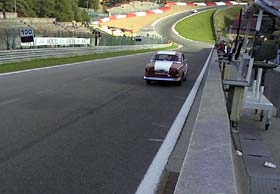 The most famous Eau Rouge corner, a steep downhill then uphill blind S-bend, is supposed to sort the men from the boys here. I readily admit I was going through with a big lift, but still coming out flat in fourth gear in a gently oversteering drift that produced elevating tummy tingles. The Irish chaps had discovered a spectacular technique of entering the corner absolutely flat, banging the brakes momentarily at the first apex and then powering well sideways up the hill. They reckoned it could be worth up to two seconds a lap. The most famous Eau Rouge corner, a steep downhill then uphill blind S-bend, is supposed to sort the men from the boys here. I readily admit I was going through with a big lift, but still coming out flat in fourth gear in a gently oversteering drift that produced elevating tummy tingles. The Irish chaps had discovered a spectacular technique of entering the corner absolutely flat, banging the brakes momentarily at the first apex and then powering well sideways up the hill. They reckoned it could be worth up to two seconds a lap.
Unfortunately, midway through our race this was to get the better of them. Up at the front, the Mustangs and Cortinas were mixing it with an Alfa GTA as usual before the pit stops for driver change. Just as I was beginning my stint, I came over the brow of the famous corner and was confronted by the sad sight of the PV. A huge moment had resulted in initial hefty contact with the barriers before it had rebounded and become stranded sideways across the middle of the track.. Body damage was restricted to both left hand fenders, thanks mostly to the vintage design, but the impact had bent the Panhard rod on the rear axle into something like a distorted branding iron from the High Chaparral. From then on we were happy to finish without a scratch, reliable as ever, but in this case feeling a trifle outgunned as I realised James' PV had been pulling at least a 1000 RPM more at every point on the circuit.
(Curiously, in another six-hour race at the same meeting we saw a French Amazon. Somewhat more modified than ours and running to unknown regulations, it sported fibreglass panels, front spoiler, fully linked and rose-jointed back axle, and modern wide wheels. We never got to see it on the track or under the bonnet, but by all accounts this is one of the fastest Volvos in Europe.)
Now we had only to trailer our car home and prepare for Goodwood, little knowing that a fuel crisis that had started in France was rapidly sweeping across Belgium and much of Europe including the UK. By the time we got back, the country was in a state of gridlock, panic buying had emptied all the gas stations, and the procedure of the Goodwood Revival Meeting was itself placed in doubt. Were we to be foiled at the last hurdle? Would Volvo's only appearance at the Revival Meeting be threatened by cancellation of the whole event?
That September week, England was in the grip of a fuel crisis as protesting truck drivers and farmers blockaded refineries. They were objecting to the high taxation levels on fuel, now $6.40 a gallon and rising. By the Tuesday, all the gas stations in London had pretty much run dry. Fortunately, we had managed to fill up CNA 161C in France while returning from our trip racing at Spa-Francochamps, and so as long as we could get to the circuit in Sussex and back, we should have just enough gas for our 12-lap sprint race and practices.
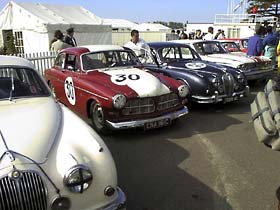 The atmosphere at Goodwood on arrival prior to the weekend was extraordinary. Most people were already dressed in their 1950s clothes, and the Drivers Mess canteen was of course decked out as if it were wartime. With so many people in uniform and a state of national emergency in the newspapers, it made for an odd feeling. Foreign visitors were embraced warmly for their efforts in arriving at all. One German team had been forced to drive on dirt tracks through dark Belgian forests to outflank highway blockades. Once on site, Avgas from the airfield was made available for those without petrol, and remarkably virtually everybody got there somehow. This party was going to go on whatever, and we were proud to be part of it. The atmosphere at Goodwood on arrival prior to the weekend was extraordinary. Most people were already dressed in their 1950s clothes, and the Drivers Mess canteen was of course decked out as if it were wartime. With so many people in uniform and a state of national emergency in the newspapers, it made for an odd feeling. Foreign visitors were embraced warmly for their efforts in arriving at all. One German team had been forced to drive on dirt tracks through dark Belgian forests to outflank highway blockades. Once on site, Avgas from the airfield was made available for those without petrol, and remarkably virtually everybody got there somehow. This party was going to go on whatever, and we were proud to be part of it.
The Revival meeting is really a three day event in which you get two practices before your race. We were in the St Mary's Trophy for "saloon" cars, and with no class structure, we were the only Volvo up against a choice invitation grid of much faster Ford Mustangs, a Falcon, a Galaxie, some Cortinas and Anglias, many Jaguars, Mini-Coopers and Alfa-Romeos, two Mercedes and a Renault Dauphine. One of the Alfas was a genuine Italian Police car, originally raced by the Carabinieri's own race team for over 20 years, complete with sign-writing and blue light on the roof.
On the first day's practice the heavens opened with literally torrents of water just gushing down as we drove out onto the track. Huge lakes formed on the tarmac and visibility was simply terrible, even worse than in the race last year. I slithered around for two laps just ahead of ex-World F1 Champion Alan Jones, who was driving the 7 litre Ford Galaxie. I then entered what I can only describe as an Olympic swimming pool on the exit of Lavant corner and spun like a paper hat in a puddle. Jonesey ploughed on for another half lap before he sensibly gave up. It was undoubtedly the one and only time I am ever likely to see him in my rear view mirror. Less wise, I pressed on, reasoning that the car's inability to pull more than 5500 revs must be due to wet electrics, until for only the second time this year, she died altogether and I coasted into the pits.
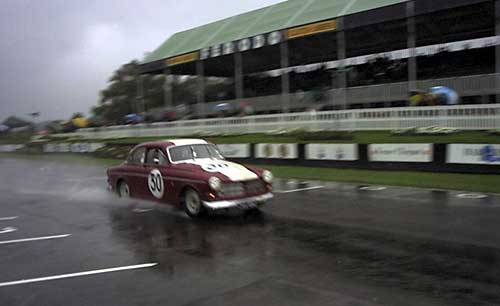
Pushed back to our paddock shelter we got a shock. While the interior might be as full of water as an old rain bucket, the engine compartment was dry like any Volvo should be. Further investigation showed the battery was down to only 9 volts. So I switched off all the accessories (wipers, pump, etc.) and she restarted cleanly, but the voltmeter would not rise. Then by chance I noticed loose alternator body bolts. Once removed, inspection showed that internal physical contact had occurred with the windings. I put everything back to how it should be, but clearly the damage was terminal as it would not charge. A new one was required, but this was a non-standard part (in this case fitted to the engine distributor side).
At this point a friend dressed as an army corporal helped engage the services of a Goodwood shuttle vehicle, driven by an army private, to take us to the only auto parts store in town still open. You can imagine being the store assistant as a figure in a '50s flying suit and bow tie, accompanied by two guys dressed as wartime soldiers, drove up in a 1958 Austin and plonked an old alternator on the counter. "We won't tell you what vehicle it's from," we said, "it will only confuse you or you'll deny you have it. Just find us one that looks like this, there's a war on you know." And remarkably they did. By seven thirty, with the help of a little drill work, we were back in business, and while we might have missed one of the World War II low flying dogfight displays, we still made it to the Ford Cosworth Champagne reception party at the Earl of March's stately home along with Stirling Moss, John Surtees, Danny Sullivan, Carroll Shelby and all the rest. Boy, Goodwood can be tough.
By next day the weather had cheered up a bit and we looked forward to an early dry qualifying session. Tony Barrett at Volvo South Service (www.amazon.uk.com) had kindly lent us some wider 5.5" steel wheels just for this race, and we were able to run on the tall Dunlop Historic Racing tyres again. The big cars can really stretch their legs on this circuit with its old-fashioned fast-flowing corners, but I was determined to try and keep up with the two Mercedes 300SEs, one of which we have been well matched against this year. So imagine my delight when pulling down the back straight I found we had magically discovered an extra 500 revs, previously missing all season. Suddenly the Viking tortoise was willing to go to 7000 revs in 3rd where I had been forced to change up at 6-6500 before. Could this somehow be related to the alternator problem? We hadn't changed anything else. It didn't make sense and I had no scientific explanation for this, but who cares, as I was soon quicker than the British Silver Mercedes of Stuart Imber and only a few seconds down from Rolf Stockerbrand's blue German example.
In the end we qualified 17 out of 30, which was a pretty good effort from the car, ahead of all but one Alfa and both the Ford Anglias, which I did not expect. Certainly out of the slower corners the car could be drifted in the most satisfying opposite power lock slides, and I was now beginning to think with a bit more help from the driver she could make up the gap to a whole gaggle of cars that were just up the grid.
By now the paddock was awash with spectators in period clothes, and the unique atmosphere of Goodwood was in full swing. Old Warbirds flew overhead and mixed with the sound of vintage racing engines. We were bowled over by the number of visitors to the Volvo; one old driver from Scandinavia who introduced himself, in broken English with an unpronounceable name, seemed almost close to tears as he reminisced about competing in an Amazon. Visitors from Denmark kindly offered advice and contacts for tuning. 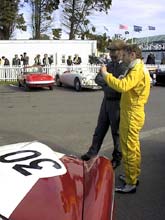 I lost count of the number of people who said they remembered one fondly from childhood. Goodwood Competitions Manager Richard Sutton, when told of all this afterwards, dubbed them the "Volvisti." But the highlight of the weekend was a visit from none other than Ken Rudd himself, the man whose Ruddspeed Volvos in the 1960s had been the inspiration for our project. I lost count of the number of people who said they remembered one fondly from childhood. Goodwood Competitions Manager Richard Sutton, when told of all this afterwards, dubbed them the "Volvisti." But the highlight of the weekend was a visit from none other than Ken Rudd himself, the man whose Ruddspeed Volvos in the 1960s had been the inspiration for our project.
Ken, who was a famous star of sports car racing at Goodwood in the 1950s, had come all the way from Spanish Gibraltar (and not retirement in the Caribbean as we had been led to believe). Rudd had never actually raced Volvos himself but provided many tuning parts, including the car identical to ours (featured in Anders Clausthalers book on Volvos), that I had seen in a photo of a grid at the Nurburgring in 1964. This car had been raced by a director of Ruddspeed called Tony, but was rolled out of this particular race at the 'Ring with none other than a broken rear halfshaft. Ken then told an amusing story of how they would bring a Ruddspeed Amazon station wagon to press track-driving days in the mid 1960s. One time, having proceeded to lap all the Alfa-Romeos present, the organisers had to ask him to slow down, as it was proving an embarrassment to the Italian importers' sports and GT cars.
That evening I was at last joined from London by Denise, and we attended our generous host's grand party of the whole event. This year it had a Safari theme and Lord March had converted a substantial aircraft hanger into the most splendid, gigantic and dramatic jungle night club scene imaginable, with full service dinner for many hundreds of guests. Complete with an indoor water-hole with amazing metal animal sculptures by Micky Bolton (www.weldartist.com), it included a full size Jaguar, made from the metal of a Jaguar car, for presentation to the Jaguar company! Three bands plus dancing meant this was to be a late night.
And so to the race. In almost perfect sunny September afternoon conditions we lined up for the start of the St Mary's Trophy. This I realised was to be the first "standing" start I had done with the car since the debacle in our first outing at Donington Park a year before. This time I aimed to use fewer revs for a steady take off, and a little practice on the green flag lap showed nothing amiss. In traditional style the race is started by a man waving a Union Jack flag, and I was determined to get into the space between the Mini and the Mercedes in the row in front. Imagine my dismay as once again, dropping the clutch and after an initial jump forward, she first bogged down and then almost died away completely before stuttering back to life. The rest of the grid were already away, with the Mustangs proving totally dominant up front. I would have to make up ground fast where I could, and while I got back past a few cars, it was not till the end of the first lap that I managed to get back near to my original qualifying position, out-braking the silver British Mercedes into Woodcote corner at the end of the Lavant straight. I then set off in hot pursuit of the blue German Mercedes, by now just tantalisingly out of reach. And it was at this point I forgot that we were the Viking tortoise and made a slight error driving through the famous Goodwood chicane. This is flanked directly by two walls, originally concrete, now something else, thank goodness. I just barely kissed the one on the left hand side, but it was sufficient to push the front bumper blade onto the tyre. Increasing rubber smoke meant disaster was only a matter of time away, and I eventually was forced to make a pit stop, wisely as it turned out, for crew chief Nick Morgan and top Volvo mechanic Dave Wright to wrench it free. From then on I just could not quite close up the distance lost on the track to the silver British Mercedes, and we ended up 16th overall, with a big groove cut in the tyre. Nevertheless, I was delighted we finished; we had at least beaten all the Alfas.
Afterwards, Dave confirmed this problem off the line has also plagued many rally cars he has dealt with; short term fuel starvation is one theory. I still have no sensible answer to this or our increased engine performance. VClassics readers are welcome to offer suggestions. Collision damage is restricted to a much-buckled fender and a slightly embarrassed driver.
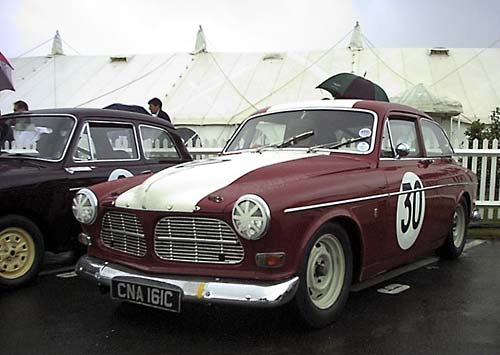
All in all it's been a good year of introduction to Volvos and how to race Amazons in particular. Thanks to all the help I have received from VClassics online contributors and others, we have been able to develop the car steadily in an environment where we have been the only one. We need more power and less weight, but then who doesn't. I have grown to admire the Viking tortoise, and after four and a half hours racing plus qualifying and road miles in between, we have suffered only two failures, both in practice. Not bad when racing a 35-year-old sedan that lives on the street. The uprated halfshafts have held out and oil pressure is as good as it was at the beginning. Seems like an ideal car for next year's old Nurburgring classic marathon over in Germany. That's what I am thinking, anyway. There's plenty of room in the trunk for a big fuel tank. Now, if only I could persuade the family to come too... perhaps in their own car.
Back to part one | Back to part two
Photos courtesy of Joel Wykeham
|
